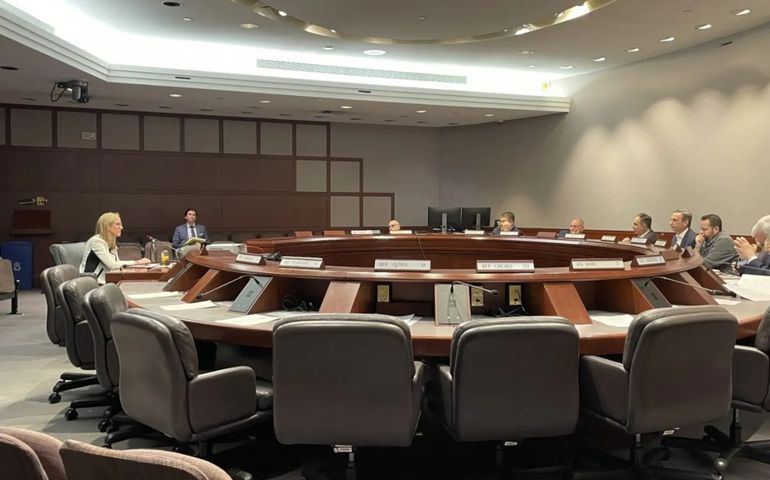Processing Your Payment
Please do not leave this page until complete. This can take a few moments.
- News
-
Editions
View Digital Editions
Biweekly Issues
- April 29, 2024
- April 15, 2024
- April 1, 2024
- March 18, 2024
- March 4, 2024
- February 19, 2024
- February 5, 2024
- January 22, 2024
- January 8, 2024
- + More
Special Editions
- Lists
- Viewpoints
- HBJ Events
- Business Calendar
- Custom Content
Spotlight on film tax credit as DECD reports to legislature
 ERICA E. PHILLIPS / CT MIRROR
Alexandra Daum, head of the Department of Economic and Community Development, addresses members of the General Assembly's nominations committee on January 26, 2023.
ERICA E. PHILLIPS / CT MIRROR
Alexandra Daum, head of the Department of Economic and Community Development, addresses members of the General Assembly's nominations committee on January 26, 2023.
One of Connecticut’s most expensive business tax credit programs — which has awarded over $1.5 billion to the film, television and digital media industry since its inception in 2007 — appears to have lost money in 2022, as it has for over a decade running.
But the Department of Economic and Community Development recommends continuing the programs, which include a credit of up to 30% on production-related spending and another credit of up to 20% aimed at incentivizing construction of new production facilities.
DECD is slated to present its annual report, an impact analysis of the state’s array of business incentive programs, to a joint legislative committee Friday. At last year’s presentation, then-commissioner David Lehman suggested lawmakers consider “dialing back” the tax incentives for film, television and digital media.
This year, under Commissioner Alexandra Daum, DECD may be changing its tune.
In the annual report, agency analysts used a new methodology to calculate the film tax credit program’s impact in fiscal year 2022, starting with larger estimates of both the number of jobs created in the sector and the state revenue gained per job, relative to previous annual report estimates.
Even with those adjustments, Connecticut’s Film and Digital Media Production Tax Credit essentially broke even last year, according to the report. The Film Infrastructure Tax Credit amounted to a net loss of $11.5 million.
In an emailed response to questions, DECD spokesman Jim Watson said the estimated number of jobs attributable to the film and digital media credit was “conservative,” adding that it was “not limited to the productions that claimed credits in FY22.”
And the price tag on the infrastructure credit, he said, “should not be viewed as a complete picture of the incentive’s impact.”
The film tax credit endures
Getting a complete picture of the film tax credit’s impact has been a challenge for Connecticut lawmakers.
In its 2019 annual report, DECD found that over the previous decade, the average economic impact of the Film and Digital Media Production Tax Credit amounted to a loss of $58.5 million in net revenue per year — well over half a billion dollars in all. Rather than issuing a recommendation that year, the department commissioned a consultancy to study the industry’s economic impact while the credit remained intact.
That study, which came out last year, found that the industry had generated economic benefits for Connecticut that would not have occurred in the absence of the incentive program. Still, just a few months later, DECD’s Lehman recommended phasing it out.
Lehman noted that on a per-capita basis, the cost of Connecticut’s film industry tax incentives was second only to one other state, Georgia, where a recent audit revealed waste and poor management within the program. In California, legislative analysts have found the economic impact of that state’s film tax credit program to be unclear.
Then, last year, New Jersey expanded its tax credit from 30% to 35% in certain counties. Producers in Connecticut said they immediately experienced fallout as productions left the state to chase lower-cost locations.
That led to robust lobbying efforts this year from the Connecticut Film and TV Alliance, a growing coalition of producers, actors and technicians. The group is seeking a credit program similar to what New Jersey is offering.
Instead, lawmakers put forward a narrower proposal. House Bill 6929 would allow companies to apply more credit toward sales and use taxes they owe; it would also lend transparency to the program, requiring recipients to report details annually about the jobs they create. (A separate legislative proposal, which sought to phase out the film tax credit program, died in the Finance, Revenue and Bonding Committee before receiving a public hearing.)
Industry advocates, including labor unions representing actors and production workers, haven’t let up in their push for the higher credit. Jonathan Black, a producer and vocal member of the Alliance, said the group planned a meeting with legislative leaders this week.
Lawmakers will have a chance to dig deeper into the program’s costs and benefits during the DECD presentation Friday. Still, with a brand-new methodology for calculating economic impact, the agency may not be able to provide definitive answers.
Connecticut Voices for Children, a longtime opponent of the film industry incentives, has repeatedly pointed out that the state’s pre-2022 estimates showed losses of nearly $80 million a year in revenue from the various film, TV and digital media credits.
That “more than offset the average total gain from the other major business assistance tax credit programs,” CT Voices policy director Patrick O’Brien wrote in testimony to the legislature on H.B. 6929.
In fiscal year 2022, Connecticut paid out more than $144 million in film tax credits — a figure CT Voices has noted is higher than the $125 million the state spent on the child tax credit.

2022 Giving Guide
This special edition informs and connects businesses with nonprofit organizations that are aligned with what they care about. Each nonprofit profile provides a crisp snapshot of the organization’s mission, goals, area of service, giving and volunteer opportunities and board leadership.
Learn more
Subscribe
Hartford Business Journal provides the top coverage of news, trends, data, politics and personalities of the area’s business community. Get the news and information you need from the award-winning writers at HBJ. Don’t miss out - subscribe today.
Subscribe
2024 Book of Lists
Delivering Vital Marketplace Content and Context to Senior Decision Makers Throughout Greater Hartford and the State ... All Year Long!
Read Here-
2022 Giving Guide
This special edition informs and connects businesses with nonprofit organizations that are aligned with what they care about. Each nonprofit profile provides a crisp snapshot of the organization’s mission, goals, area of service, giving and volunteer opportunities and board leadership.
-
Subscribe
Hartford Business Journal provides the top coverage of news, trends, data, politics and personalities of the area’s business community. Get the news and information you need from the award-winning writers at HBJ. Don’t miss out - subscribe today.
-
2024 Book of Lists
Delivering Vital Marketplace Content and Context to Senior Decision Makers Throughout Greater Hartford and the State ... All Year Long!
ABOUT
ADVERTISE
NEW ENGLAND BUSINESS MEDIA SITES
No articles left
Get access now
In order to use this feature, we need some information from you. You can also login or register for a free account.
By clicking submit you are agreeing to our cookie usage and Privacy Policy
Already have an account? Login
Already have an account? Login
Want to create an account? Register
Get access now
In order to use this feature, we need some information from you. You can also login or register for a free account.
By clicking submit you are agreeing to our cookie usage and Privacy Policy
Already have an account? Login
Already have an account? Login
Want to create an account? Register






0 Comments